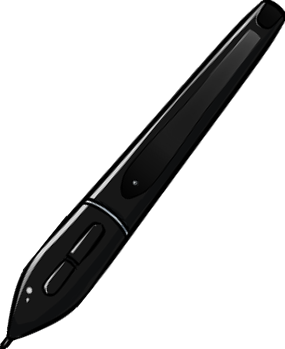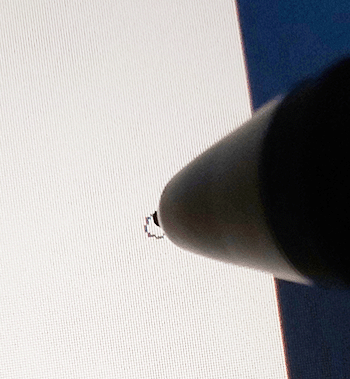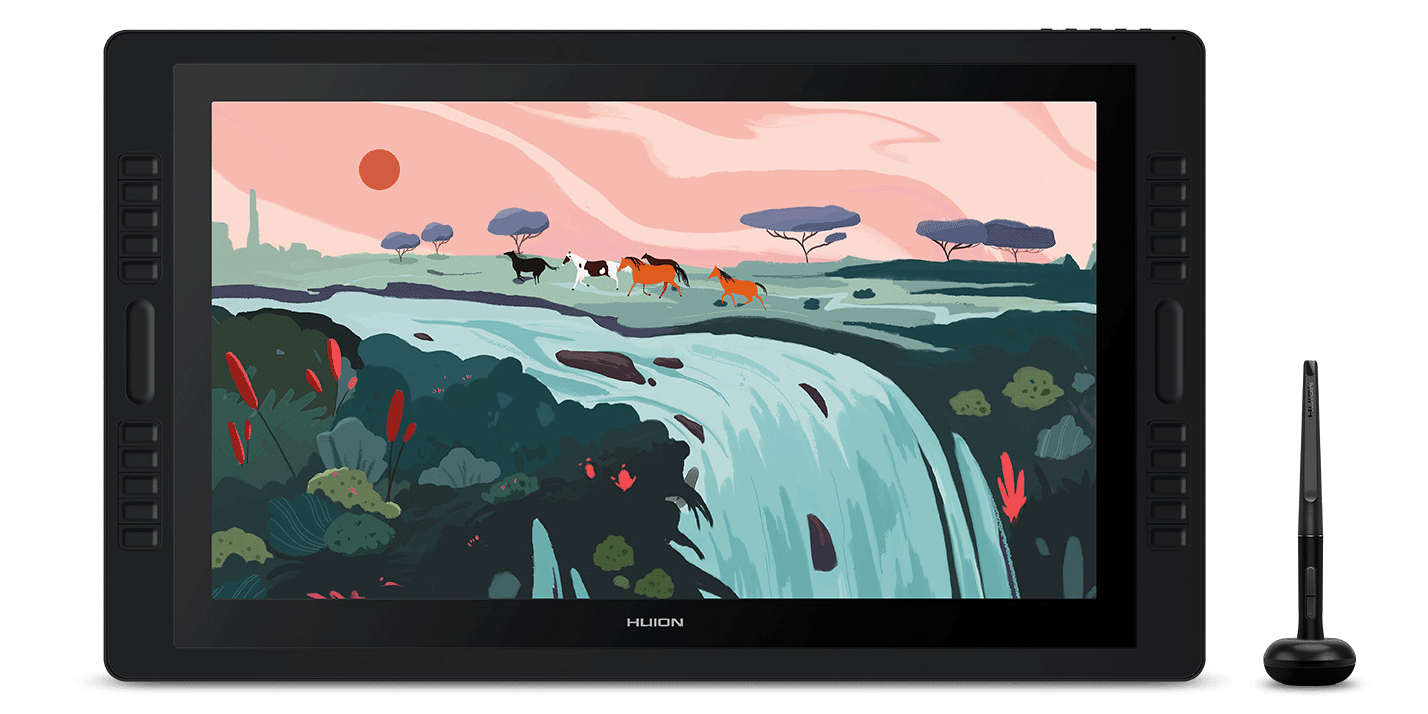Huion Kamvas Pro 24 Review and Comparison


Table of Contents
The comparisonInitial impressionsConsUnresponsive edges of the screen (myth)Tilt responsivenessButton layoutProsSharpnessSize and resolutionWeightConclusionShould I get a Pro 24?Should I get a GT-191?Black Friday deals seem to to be a bit lackluster this year, but a discount is a discount, even if the sale price is still over 1k. So: is it worth it to take this chance to get a Kamvas Pro 24?
...Maaaaybe.
The comparison
My old tablet—a Huion Kamvas GT-191 of 5 years, possibly less than two of which have been actually spent drawing—started slowly dying over a month ago. You can guess how helpful it was to not be able to draw even when I tried to make time for it, so despite it not being The Sale Date™ yet, I caved and bought a new one earlier this month. My desires were:
- Big
- HD
- Not over $1200 because what the fuck
After reading reviews into the night, the titular tablet (2.5K QHD edition) ended up satisfying my criteria—and there was a $200 discount on it already—so I decided to go with it. I went with it despite the rather short lifespan of my previous Huion tablet because, aside from that part, my experience with it had been basically flawless (disclaimer: this is coming from someone who had never used another screen tablet in their life), and the reviews and price point were both pointing me towards it. Reviews of Cintiq on the other hand were largely on the negative side, speaking of progressively lower and lower quality control, so I decided to just go with a brand that I already trusted.
Initial impressions
I had been only using the new tablet for just over a week, but the first day was quite different from the third one, so I'll constrain initial impressions to just being the first two days.
My old GT-191 was pretty great. Yes, I had no prior screen-tablet experience, but I also don't remember having had any trouble with its setup process. Using it was intuitive, no settings needed to be tweaked, and I recall being quite happy at how I was able to draw directly on the screen.
This should translate to an easy upgrade, right? —But it didn't.
First, pen-to-screen calibration was off. In fact, it's still off. I've re-done the calibration several times, but I still can't get the brush tip to actually be at the center of the pen nib.

I had made a mental note to myself to fix it the next day, but I think I just got used to it lol. Given that I had only used it a total of around 2 hours over 3 days, it's...not that big of a deal I guess? I'm still drawing lines that aren't quite like how I used to be able to pull them—there's this kind of flick at the end that I couldn't get rid of for the first several days—but the surface material is different, so perhaps the main issue lies in getting used to that. I did adjust the pressure sensitivity and all that to try to get it to work like the previous pen, but I honestly found the old tablet easier to draw lines on the those first few days. Again—could just be a matter of adaptation.
Cons
Unresponsive edges of the screen (myth)
One common complaint in the reviews was that the edges of the screen were unresponsive. I ignored this because...idk but lo and behold; this was actually true!!!
Until it wasn't?
When I first used the tablet, my pen straight up lagged (or so I thought). I apparently had it had it close to the edge of the screen or something, but either way, I was ready to open up a support ticket it was that bad. Never ended up doing it because I'm busy lol, but as I used it more and tested it just now, the pen is actually perfectly responsive at the edges. The problem is this:
You have to put the tip very close to the screen in order for it to be sensed.
The sensors at the center of the screen are significantly better; I don't have to risk actually touching it in order for my pen's movements to still be tracked. At the edges however, intimacy must rise. Making this worse is that there's a configurable slider control at both sides of the screen that cannot work independently from each other, so your hand will most likely accidentally brush against and trigger its functionality before your pen nib gets sensed there.
Tilt responsiveness
Kamvas Pro 24 boasts a ±60° tilt-sensing range. I have the pen quite tilted when I toggle layers on and off a lot of times, and, probably coupled with the fact that the layers panel is close to the edge of the screen, this has caused the problem of me having to tap several times before things respond. Again, something I was going to open up a ticket about, but ended up having less and less trouble with as I went along.
The thing is—GT-191 says nothing about tilt responsiveness. It literally has a blank field in its specs table for that. And yet, it is so much better!! As long as the pen nib was touching, it was sensed, and I literally never even had to replace that first nib. Why is this newer model at twice the price a downgrade from this functionality??
Button layout

Mentioned in a previous section is that there is a slider control hooked up to both sides that can't be separated. This is disappointing, not only for the reason that you will accidentally brush against it at some point, but because literally all the other buttons can have separate functionality from their other side.
Speaking of said buttons, I have no idea how you're supposed to actually click them. The hand holding the pen is going to hold the pen; using it to press buttons feels unnatural. Maybe some people do do this and it's just a matter of, again, adaptivity, but I have never used the buttons on that side and most likely will never used them.
As for the buttons on your free hand...
How are you supposed to push the ones up top?? Unless you have the screen directly beneath you, eg. without tilting it upwards at all, there is no place for your hand to rest; you'd have to reach up to press those buttons, which just feels tiring and unnatural. I have no idea how one is supposed to use these buttons without having to do an arm endurance workout while you're at it.
Pros
Sharpness
The sharpness was honestly actually a con when I first started; it was too sharp, like it almost had chromatic aberration around the edges of each word. I fiddled a bunch with the settings but couldn't get it less sharp without just straight up making it blurred. Thus, I gave up...
...and now it's just fine? Pretty great, even?
Adaptivity apparently. Maybe I'm too used to looking at budget screens ¯\_(ツ)_/¯
Anyhow, other than the initial over-sharpness, one thing was immediately clear:
Size and resolution
Bigger is so much better. HD is so much better!
I wondered if artists really needed HD before and now I know: yes, you do. Do you need 4K? I can't justify affording that so I have no idea, but just this 2.5K was already a world of difference.
Everything was so clear. Little inconsistencies in strokes that I had never noticed before became apparent. This works in conjunction with the larger size; even zooming into 100% for the huge canvas I have no longer feels like extra detail work. I can just see the whole picture, at its original size, without having to zoom in and out or move the canvas around.
So if your desk space can afford it (I really just forced mine on there—bought a monitor arm today to mitigate that, will see how that goes), definitely get a tablet as big as your eyes can handle viewing at drawing distance. 24" is perfect in my opinion; too big and your eyes will have to scroll.
Weight
A mini-pro, but worth mentioning: Despite being significantly bigger than my GT-191, this new tablet actually feels lighter. I didn't check the specs but it's definitely been built in a way that's easier to handle, despite its size.
Conclusion
Should I get a Pro 24?
The number of pros and cons I listed may be balanced, but the importance of the pros definitely outweighs the cons. The reason I didn't open up with "yeah it's worth $1k" is because I don't feel that the price difference (around +$500), for the amount of good new functionality and hardware given, is quite so worth it. Coupled with the fact that it's definitely not problem-free—which is a label I can surprisingly give my older tablet, back when it worked—if I hadn't already invested time and money into this, I would actually check to see if there are alternatives first. No gaurentees that an alternative would be actually worth it though!
Should I get a GT-191?
Only V2 is available for sale now and I'm not sure what the difference is, but if you want a tablet that just works and won't break your bank or your desk and don't need super clear linework, then—yes, this is actually worth it. I haven't personally compared the specs for this to ones around the same price range recently, but judging by reviews and experience, I do think that it is a better bang for your buck than the upgrade I ended up buying. 19.5" definitely isn't small, and the lower resolution is unnoticable if you don't have anything to compare it with. If you're worried about the short lifespan mine had, do note that it had been dragged through two cross-province moves—the second of which was quite bad—which definitely contributed to its low longevity.
Either way, this has been a non-sponsored review of Huion Kamvas Pro 24 no I don't have an affiliate link. Perhaps one day I shall know what it's like to get tablets to review for free, but until then; the only regret I have for getting this is that I couldn't wait for the extra $90 coupon.


 Spirall
Spirall